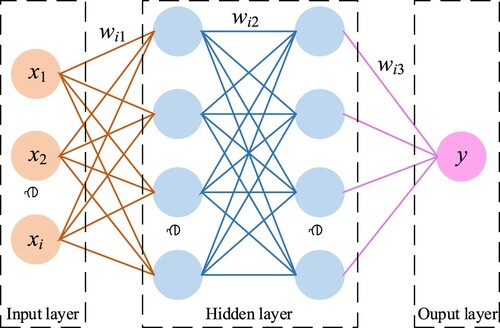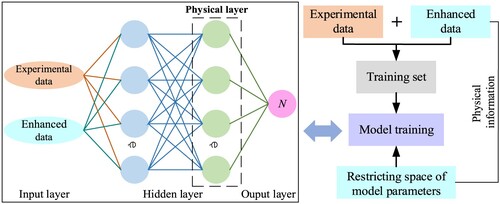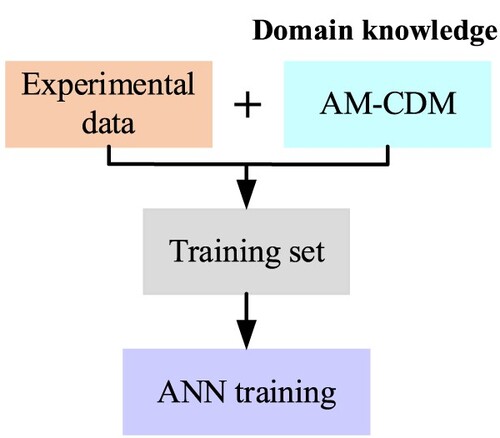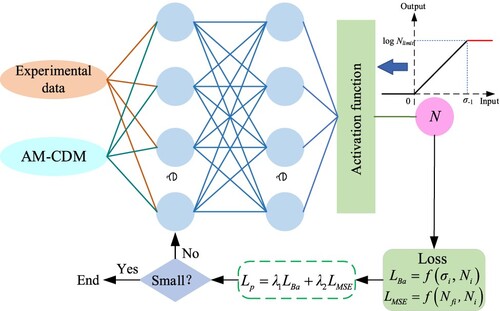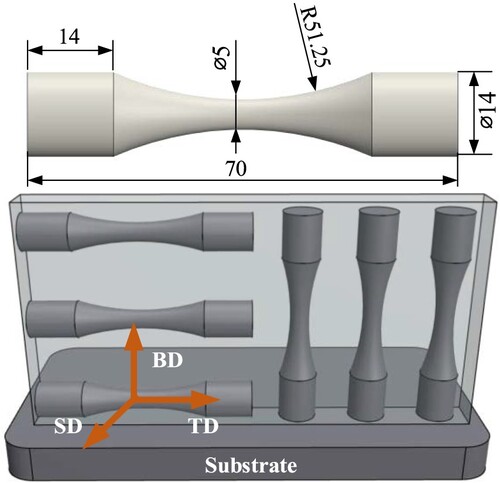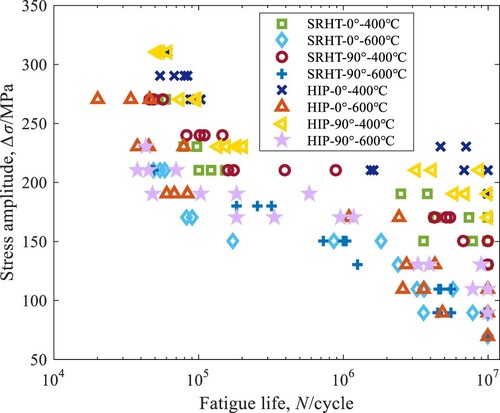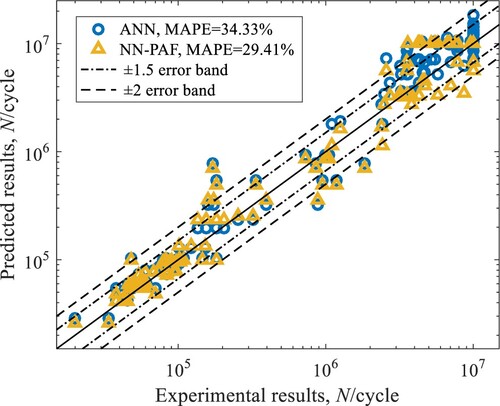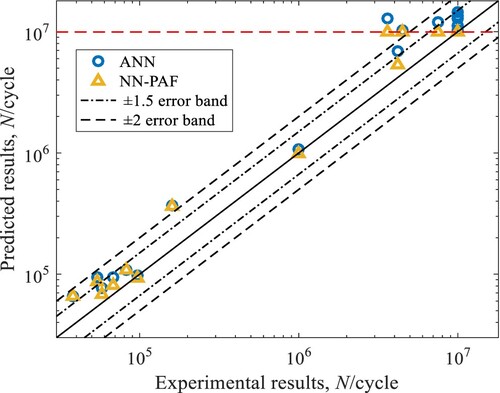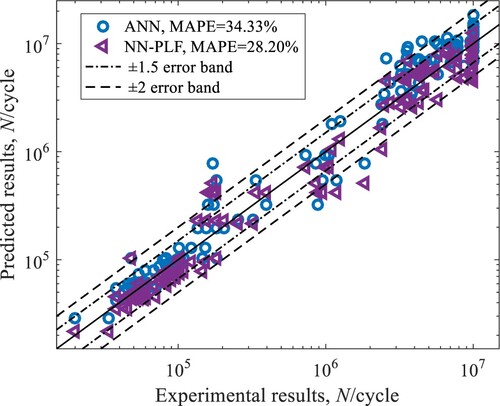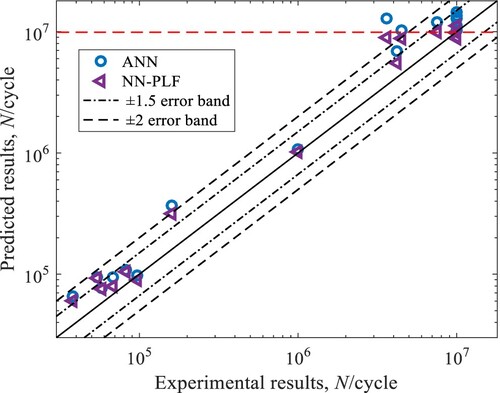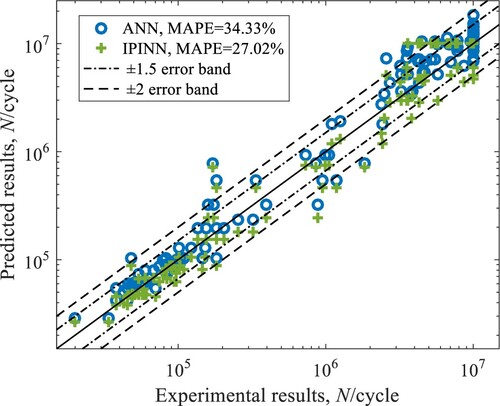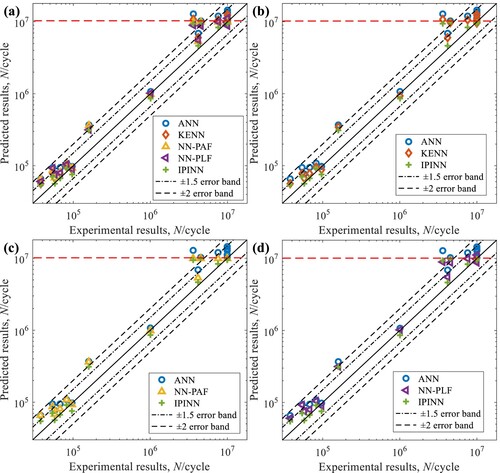 ?Mathematical formulae have been encoded as MathML and are displayed in this HTML version using MathJax in order to improve their display. Uncheck the box to turn MathJax off. This feature requires Javascript. Click on a formula to zoom.
?Mathematical formulae have been encoded as MathML and are displayed in this HTML version using MathJax in order to improve their display. Uncheck the box to turn MathJax off. This feature requires Javascript. Click on a formula to zoom.ABSTRACT
The inherent ‘black-box’ characteristic of neural networks renders the physical interpretability of fatigue life prediction challenging, resulting in physically inconsistent prediction results. In response to this challenge, a multi-physics information-integrated neural network framework is proposed for fatigue life prediction. Rooted in the continuous damage mechanics with embedded additive manufacturing process parameters (AM-CDM), coupled with activation functions and loss functions that amalgamate physical information, a multi-tiered and multi-physical information source network framework emerges. The framework incorporates the outcomes of the AM-CDM model as input features for domain knowledge enhancement, embeds the fatigue limit within the activation function, and establishes a loss function integrating the physical model. Through the integration of multiple physical information, the model can be restricted by different physical constraints during training, thereby improving its prediction accuracy and physical consistency. Validation of the proposed framework is conducted using laser powder bed fusion (LPBF)-fabricated Hastelloy X subjected to varying orientations, post-treatments and test temperatures. The findings demonstrate that the prediction accuracy of an integrating-physics-informed neural network (IPINN) is improved by 27.51%, and its life prediction results are capped at the fatigue limit life, yielding a better physical consistency. The IPINN framework provides a novel perspective for fatigue life prediction.
1. Introduction
As a revolutionary manufacturing technology that utilises layer-by-layer deposition of materials, additive manufacturing (AM) possesses unique technical advantages in facilitating the free design and integrated shaping of complex components. AM, owing to its ability to effectively balance the rapid manufacturing of complex shapes and high-performance metal components, finds extensive applications in aerospace, energy and other fields [Citation1–3]. The distinctive manufacturing process results in AM parts exhibiting anisotropy and orientation complexity, leading to mechanical properties and fatigue behaviour distinct from traditional forgings [Citation4]. Accurately predicting the fatigue life of AM parts to ensure their service reliability is a critical challenge in driving the application transition of AM components.
The inhomogeneity of the microstructure of AM parts results in significant dispersion of fatigue life. Fatigue life prediction under traditional paradigms relies on idealised and simplified models, which struggle to fully account for the unique microstructural features of additively manufactured metals. Furthermore, the fatigue behaviour of AM parts is influenced by multiple variables including material properties, geometric structure, manufacturing processes, orientation and service conditions. The coupling of factors makes it challenging for physical models to accurately reflect the random, mutant and nonlinear uncertainties present in reality, limiting the applicability of traditional fatigue life prediction models and hindering accurate prediction of the fatigue life of AM parts. Therefore, there is an urgent need to develop accurate and reliable methods to assess the fatigue properties and fatigue life of AM parts.
The rapid advancement in computational science has propelled machine learning (ML) to emerge as a crucial method for revealing complex relationships among material properties and associated characteristics. Particularly in fatigue life prediction, ML can break the physical limitations of different conditions and make uniform predictions, and it demonstrates the potential to overcome limitations of traditional analytical and empirical methods [Citation5,Citation6]. ML models harness information such as fatigue test results, microstructural characterisations and process parameters to capture the intricate relationships among multiple variables, thereby establishing complex mappings between fatigue life and various factors to enable accurate and reliable predictions [Citation7–10]. In recent years, ML has made significant strides in fatigue life prediction. For instance, Jia et al. [Citation11] proposed a deep belief network-based backpropagation neural network to predict the fatigue life of additively manufactured Ti6Al4 V in very-high-cycle fatigue and analysed the effect of laser energy density on the fatigue behaviour of Ti6Al4 V. Centola et al. [Citation12] employed neural network to predict the fatigue life of additively manufactured Ti6Al4 V parts based on process parameters, heat treatment, surface treatment and stress amplitude and investigated the effects of individual process parameters on fatigue life. Furthermore, Xie et al. [Citation13] considered the factors such as the randomness of multiaxial loading path data, sample geometry and test system errors, utilising neural networks, support vector machines and random forests to reliably predict the fatigue life of FGH96, and obtained a fatigue life interval with a probability distribution.
Although the ML method has been widely applied to fatigue life prediction, the ‘black-box’ characteristics of ML models lead to a lack of physical interpretability in fatigue life prediction, and the absence of physical constraints results in physically inconsistent prediction results. The development of a physics-informed neural network (PINN) effectively addresses this issue [Citation14]. Through the integration of physical knowledge and theoretical constraints into a neural network, the network, during the training process, not only learns the complex relationships among the data but also utilises prior knowledge from physical laws to constrain the learning process [Citation15]. This approach enables the network to effectively establish mapping relationships that align with experimental outcomes and adhere to fundamental physical principles, thereby enhancing the model's physical interpretability. For instance, Zhou et al. [Citation16] proposed a fatigue life prediction method combining physics and data-driven approaches. By developing a deep belief network to reveal the relationship between physical model parameters and fatigue life, and using a variational autoencoder to expand the training samples, the results showed that the prediction results were within a 1.5 error band. He et al. [Citation17] introduced a multiaxial fatigue life prediction framework combining generative adversarial network and physical models, where three fatigue life prediction models were incorporated into the loss function of the generative adversarial network. The results demonstrated that the model with appropriate physical constraints outperformed the neural network in predictive performance. Additionally, Chen et al. [Citation18] constructed a multi-fidelity network framework by embedding physical models into hidden neurones as activation functions to accommodate mixed data of different fidelities. The results indicated that the proposed network framework could produce physically consistent and accurate results and performed well in extrapolating fatigue life prediction.
For AM-built parts, the defect is a significant contributor to the uncertainty of their fatigue life [Citation19], and a defect-driven physics-informed neural network can capture defect information during training progress and further explore the effect of defects on fatigue life [Citation20–22]. Furthermore, Wang et al. [Citation23] and Salvati et al. [Citation24] combined fracture mechanics considering process defects with the ML model, demonstrating that the models integrating physical information could maintain high prediction accuracy and mitigate overfitting in sparse fatigue data scenarios. PINN combines the advantages of purely data-driven ML methods and traditional physical models, holding immense potential for fatigue life prediction [Citation25–28].
However, current PINNs typically integrate singular physical information or constraints with neural networks, limiting the model's ability to identify multiple physical processes and the coupling effects of various factors. Therefore, this paper proposes a multi-physical information-integrated neural network framework. By integrating the enhanced features of the AM-CDM model, the activation function fusing fatigue limit, and the loss function constructed based on the Basquin formula into the neural network, a multi-tiered and multi-physical information source network framework is formed. The model is validated by laser powder bed fusion (LPBF)-fabricated Hastelloy X with different orientations, post-treatments and test temperatures. The integration of multiple physical information enables the model to comprehensively capture fatigue-related physical information and be restricted by various physical constraints during the training, thereby improving the prediction accuracy and physical consistency of the model. The integrating-physics-informed neural network (IPINN) framework offers a novel perspective for fatigue life prediction.
2. Theoretical basis of the model
2.1. Artificial neural network
An artificial neural network (ANN) is an ML model that simulates the information processing of biological neural networks. Through the hierarchical structure of neural networks, it can learn complex nonlinear mapping relationships between inputs and outputs based on data. A neural network consists of neurones, which form a network according to a hierarchical structure, including the input layer, hidden layer and output layer. The input layer receives raw data, the output layer generates final prediction results, and the hidden layer is responsible for learning patterns and features within the data. illustrates a four-layer neural network structure with two hidden layers.
The neural network facilitates information transmission through connections; each connection has an associated weight that adjusts the impact of one neurone's input on the next layer. displays the working principle of a single neurone. The neurone receives all inputs and weights them as a sum, followed by a nonlinear transformation through an activation function to generate an output. The output of a node is represented by Equation (1), which then serves as input for the next layer of neurones. During network training, the loss function is minimised through backpropagation and stochastic gradient descent algorithms. For the j-th neurone in the l-th layer, the i-th connection weight and bias are shown in Equation (2) and Equation (3).
(1)
(1) where w is the weight, b is the bias and f is the activation function.
(2)
(2)
(3)
(3) where t is the time step, η is the learning rate, θ is the momentum factor to prevent falling into the local optimal solution and E is the loss term.
The training of neural network relies on vast datasets and specific rules, including the definition of the loss function, selection of optimisation algorithms and determination of activation function, all of which play a crucial role in the network's performance. The loss function is the core of the backpropagation algorithm. By calculating the gradient of loss function on the model parameters, the network continuously adjusts weights and biases to minimise the prediction error of the model, as depicted in Equation (4).
(4)
(4) where n is the number of samples.
The activation function is employed in a neural network to introduce nonlinearity and transform neurone inputs nonlinearly. It allows the network to transfer and process complex information layer by layer, approximating and fitting the mapping relationships between complex inputs and outputs, thereby enhancing the expressive ability of the network. The absence of activation functions will result in multi-layer neural network structures equivalent to single-layer linear models, limiting the flexibility of the network. The commonly used activation functions in regression tasks are illustrated in .
Table 1. Information on different activation functions.
2.2. Physics-informed neural network
The neural network operates as a black-box model, where the internal mechanisms of the prediction process are unknown, lacking the physical interpretation of the fatigue life prediction process. The neural network's understanding of the fatigue damage process is limited by the physical meaning of the dataset and model structure. Datasets from different physical domains and scales cannot comprehensively reflect fatigue damage mechanisms. PINN is a novel paradigm that integrates physical knowledge with neural networks to improve its understanding of physical processes and predictive capabilities [Citation29]. PINN embeds known physical laws and their boundary conditions into the neural network. During training, the network not only learns from data-driven approaches but also utilises prior knowledge from physical laws to constrain the learning process, which can effectively learn mapping relationships consistent with observed data and adher to physical laws. Typically, the construction of PINN can be realised by the following strategies [Citation14,Citation30]. The schematic diagram of the PINN framework is illustrated in . In this work, the strategies of physical feature input and physical law constraints are employed to construct the IPINN, and the specific details are presented in Section 3.
Physical feature input (data enhancement of domain knowledge). Incorporating the physical features or physical quantities in the fatigue field as inputs to the neural network, enabling the network to utilise the prior knowledge provided by physical laws to establish boundary conditions.
Physical law constraints (limiting the update space of model parameters). Integrating the known physical laws and models into the structure of neural networks, such as embedding physical laws/models as constraints in the loss function and activation function to guide the learning process of the model to comply with physical laws.
Construction of physical constraint layer. Introducing a specific physical constraint layer to ensure that the neural network follows physical laws during the learning process. This layer serves as a medium for transmitting physical information in the network structure, directly embedding physical laws into the forward propagation process of the network.
The integration of neural networks with known physical laws renders the model more physically interpretable, enhancing its capacity to learn and predict accurately even in situations with limited data availability. Moreover, the hybrid paradigm of physics-data enables PINN to proficiently tackle multi-scale and multi-physics challenges, particularly suitable for scenarios involving multiple physical processes and coupled phenomena. These attributes collectively underscore PINN's significant potential for advancing fatigue life prediction methodology.
3. Framework of multi-physics information-integrated neural network
This paper constructs a neural network framework that integrates the enhanced features of domain knowledge, the activation function and loss function fusing physical information. The objective is to attain a fatigue life prediction model characterised by high precision and physical consistency through the amalgamation of diverse physical information within the neural network architecture. Among them, Sections 3.1 to 3.3 demonstrate the fusion strategies of three types of physical information, respectively, and Section 3.4 displays the integration of different physical information.
3.1. Knowledge-enhanced neural network
The physical information within the fatigue process is used as input features to enrich the training data of the neural network, enabling it to comprehensively learn the fatigue features and thus better understand the fundamental physical principles underlying fatigue processes [Citation31]. That not only increases the diversity of training data but also provides neural networks with more prior knowledge to establish boundary conditions. Particularly in scenarios of sparse data, leveraging domain-specific input features allows the network to train the model more effectively on the limited dataset, which is beneficial for improving the learning efficiency and predictive performance of the model.
AM process parameters (laser power p, scanning speed v, hatching space h and layer thickness t) have a significant impact on the forming quality of as-built parts during the printing process. They directly affect the thermal stress distribution and solidification rate of the melt pool by influencing the input of laser energy and controlling the laser radiation time. During the AM process, minor variations in process parameters may lead to the generation of pores and defects within the as-built parts, thereby affecting their mechanical properties and fatigue life. The presence of pores and defects can create stress concentration points, accelerate the propagation of fatigue cracks, and ultimately affect the fatigue damage evolution process of the as-built parts [Citation32]. Therefore, it is of great significance to consider the effect of process parameters on the fatigue life of as-built parts and introduce energy density into the fatigue damage evolution process. Previous work has demonstrated that the results of continuous damage mechanics with embedded AM process parameters (AM-CDM) as physical information inputs are beneficial in improving the predictive performance of the model [Citation33]. Therefore, in this work, the results of the AM-CDM are utilised as physical information features for neural network training, as depicted in .
Under uniaxial cyclic loading conditions, the fatigue damage evolution equation can be rewritten as [Citation34]:
(5)
(5) where N is fatigue life, σa is stress amplitude, σm is mean stress and m, k, α, β are the material parameters.
As well known, AM process parameters have a significant effect on porosity, manufacturing defects and microstructure, thereby affecting the fatigue behaviour of AM-built parts. To include the effect of process parameters on the fatigue life of AM-built, the laser energy density is integrated into the fatigue damage evolution. Therefore, under uniaxial cyclic loading, the AM-CDM model can be expressed as [Citation33,Citation34]
(6)
(6) where Ed is the energy density during the AM process and Ed0 is the reference energy density. Δ(Ed, Ed0) represents the effect of AM process parameters on the fatigue damage, as shown in Equation (7).
(7)
(7)
(8)
(8) The AM-CDM-based fatigue life model can be obtained by integrating Equation (6):
(9)
(9) The AM-CDM model describes the damage evolution of materials, offering advantages in predicting long-term damage behaviour. In this work, the AM-CDM model results are employed to characterise the damage process of as-built parts with AM process parameter effects under different stress amplitudes. It further investigates the impact of post-processing on fatigue life through the physical and mechanical properties of different post-processes in experimental data. A knowledge-enhanced neural network (KENN) is constructed for fatigue life prediction.
3.2. Neural network incorporating physical activation function
When employing ML methods for fatigue life prediction, the differences in scale and dimension among various features in the dataset lead the model to focus more on large-scale features, thus affecting the comprehensive capture of feature information by the model. To eliminate the impact of dimensional differences among features, the input features are normalised to map them within the range [0, 1] before model training. Normalisation balances the weights of each feature in the network, enhancing the network's sensitivity to different features. However, the fatigue life of materials or structures varies significantly across different stress levels, especially in high-cycle fatigue, where fatigue life under the same stress may differ substantially. Therefore, to better adapt the model to the entire fatigue life distribution, enhance the network's modelling capability for samples with a wide range of fatigue life and reduce the excessive analysis of extreme life values, the fatigue life is commonly subjected to a logarithmic scale transformation. For high-cycle fatigue, the fatigue life is generally mapped to within 7. Consequently, it can be seen from that in ML-based fatigue life prediction, the ReLU activation function is selected for nonlinear transformation. The schematic diagram of the ReLU activation function is depicted in a.
Figure 5. Schematic diagram of activation function: (a) ReLU and (b) ReLU integrated with fatigue limit.
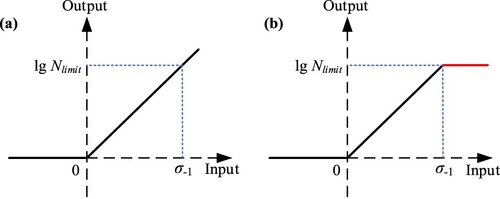
As depicted in a, when outputting fatigue life, the ReLU activation function allows the network to undergo nonlinear transformations beyond the fatigue limit life, irrespective of the output range, resulting in a trend of continued increase in fatigue life transformation. That phenomenon may cause the predicted fatigue life to exceed the fatigue limit life, presenting physically inconsistent predictions. In , σ−1 is the fatigue limit, and lg Nlimit is the life corresponding to the fatigue limit. Therefore, in this work, the fatigue limit is embedded into the activation function to obtain the physics-informed activation function, and a neural network incorporating the physical activation function (NN-PAF) is established. That incorporation ensures that the network outputs physically consistent prediction results, as shown in Equation (10).
(10)
(10) In this work, lg Nlimit is introduced as the limitation of output range when the ReLU activation function is converted. This strategy ensures the predicted results of the neural network within the fatigue limit life Nlimit range, thereby achieving predicted results consistent with experimental life. As illustrated in b, lg Nlimit serves as the upper threshold of the activation function's output, ensuring that the model can control the prediction range of fatigue life and prevent the prediction results from exceeding the fatigue limit life. The incorporation of fatigue limit is beneficial for improving the physical interpretability of the model and ensuring that the prediction results are consistent with experimental theory. It provides a more reliable and physically consistent path for the ML-based fatigue life prediction method.
3.3. Neural network incorporating physical loss function
The loss function serves as a metric in neural networks to measure the difference between model predictions and actual results. During training, the backpropagation and gradient descent algorithms continuously adjust the weights and biases according to the gradient of the loss function to minimise the loss and reduce the model’s prediction error through repeated iterations. In this work, a fatigue life loss function integrating a physical model is constructed based on the Basquin formula. By embedding the known physical model into the network's training process, a neural network incorporating physical loss function (NN-PLF) is developed, ensuring the network adheres to physical laws during learning, thus improving the physical consistency and interpretability of the model. Meanwhile, the physics-informed loss function restricts the updated space of network parameters, aiding in preventing the model from learning unreasonable mappings for physical processes. Furthermore, the constraints and limitations of the physical model provide additional information to the model, especially in scenarios with sparse data, facilitating the network to learn the physical laws of the fatigue process and reducing the reliance on the dataset.
The loss function incorporating the Basquin formula enables the network to learn more in line with the physical laws of the fatigue process during training. However, the parameter characteristics of the Basquin formula allow the model to have a better predictive performance under the same conditions. To improve the model's generalisation performance and ensure high predictive accuracy under diverse conditions, we further introduce the mean square error (MSE) loss term LMSE into the loss function. By adjusting the weights λ of the two loss terms, the network can adaptively adjust different weights and biases while learning the physical trend of the Basquin equation, thus achieving accurate and reliable predictions under varying conditions. The neural network framework integrating-physics-informed loss function is illustrated in .
The fatigue life loss function Lp integrated with the Basquin formula can be expressed as:
(11)
(11) where LBa is the loss term constructed based on the Basquin formula.
(12)
(12)
(13)
(13) where σi is the input stress amplitude, σ’f is the fatigue strength coefficient, b is the fatigue strength exponent, Ni is the output fatigue life, and Nfi is the experimental life corresponding to σi.
3.4. Integrating-physics-informed neural network
Feature input of domain knowledge is a data enhancement strategy. In this work, the AM-CDM model results are utilised as input features to characterise the damage process of as-built parts with AM process parameter effects under different stress amplitudes. That approach facilitates the network in learning the fatigue damage evolution laws of as-built parts. Concurrently, the fatigue limit is embedded into the ReLU activation function to enable the strict control of the model output and avoid the prediction results exceeding the fatigue limit life, ensuring consistent predictions with experimental life. Furthermore, the Basquin formula is integrated into the loss function, enabling the model to learn the physical laws of the fatigue process during the training process, which is beneficial for enhancing the model's understanding of physical constraints. The introduction of the LMSE loss term and weights allows the model to achieve accurate and reliable predictions under different conditions. In this work, the enhanced features of domain knowledge, physics-informed activation functions and loss functions are integrated into a neural network to develop IPINN. The integration of physical information is essential for enhancing the model's predictive performance, improving interpretability and ensuring physical consistency. The physical information integration framework of a neural network for fatigue life prediction is shown in .
The integration of multiple physical information allows the model to capture the physical laws of the fatigue process more comprehensively. By considering the combined influence of multiple physical processes and factors, the model can more accurately map fatigue behaviours and enhance the interpretability of predictive behaviours. Additionally, the integration of physical information ensures that the model maintains strong stability in predictive performance even in cases of sparse or missing data. The integrated framework of physical information enables the neural network to learn the physical laws of the fatigue process, thereby improving the model's physical consistency, interpretability and predictive performance.
4. PINNs-based fatigue life prediction
In this work, the experimentally obtained fatigue life of LPBF Hastelloy X is used to validate the neural network-based prediction model integrating various physical information and analyse the predictive performance of the model with different physical information under various conditions.
4.1. Experiments and modelling
4.1.1. Sample preparation and fatigue testing
The LPBF process parameters optimised using orthogonal experiments were applied to fabricate Hastelloy X samples with 67° rotation laser scanning strategy, where the laser power p = 260 W, scanning speed v = 1000 mm/s, hatching space h = 0.09 mm and layer thickness t = 0.04 mm. The printed Hastelloy X billets were processed into fatigue specimens with two different orientations based on the building direction (BD), as illustrated in . Specifically, specimens with the loading directions parallel to BD were defined as 90° specimens, while those with the loading directions perpendicular to BD were defined as 0° specimens. The surface roughness of the specimens was maintained at 1 µm. To investigate the fatigue performance of LPBF Hastelloy X with different post-treatments, the specimens in both directions were divided into two groups for stress-relief heat treatment (SRHT) and hot isostatic pressing (HIP), respectively. The stress-relief heat treatment held the specimens at 870°C for 2 h, followed by cooling in air. While hot isostatic pressing, a pressure of 160 MPa at 1175°C for 2 h was applied, and then, they were cooled in the furnace.
In accordance with the service conditions of aero-engine components, the stress-controlled fatigue experiments were conducted on LPBF Hastelloy X specimens at 400°C and 600°C with the stress ratio R = −1 and loading frequency f = 20 Hz. The fatigue testing was stopped until the stiffness decreased by 5% or the number of cycles reached 107, where the stress corresponding to 107 cycles is the fatigue limit. We obtained 8 sets of stress-life relationships for a total of 164 sets of fatigue data at different post-treatments, orientations and temperatures, as shown in .
4.1.2. Model establishment and evaluation
When selecting the number of hidden layers and neurones in a neural network, there is a need to balance the complexity and performance of the model. Appropriately increasing the complexity of the network can contribute to better capture of physical information and improve the model's expressive power. However, overly complex models may lead to overfitting, thereby reducing the generalisation performance on new data. In this work, the enhanced features of domain knowledge, physics-informed activation function and loss function are integrated into a neural network, rendering the model relatively complex. Therefore, a simpler network structure is chosen to construct the neural network, that is, a three-layer hidden layer structure with 64, 32 and 16 neurones, respectively. The Tanh activation function is employed between hidden layers for nonlinear transformation among neurones, while the ReLU activation function is used in the output layer to output fatigue life. The Adam optimisation algorithm is selected for training the network, with a learning rate of 0.001 and 2000 iterations. This study compares the predictive performance of different physical information integration strategies under the same network structure and subsequently optimises the network structure.
It has been shown that comprehensive characterisation of material properties using multi-source features can contribute to improve the model’s learning capabilities and strengthen the mapping relationship between model inputs and outputs [Citation35,Citation36]. Therefore, the physical and mechanical properties of LPBF Hastelloy X were evaluated. The stress σ, temperature T, sampling direction, elastic modulus E, and coefficient of thermal conductivity K were selected as model inputs to characterise the experimental conditions, structural features, mechanical properties and physical properties of the samples. By establishing the mapping relationship between these features and fatigue life, the fatigue properties of LPBF Hastelloy X specimens under different orientations, post-treatments and test temperatures are revealed.
In this work, 145 samples were randomly selected for training, and the remaining 19 samples were reserved for testing purposes. Detailed information regarding the test set is provided in , which encompasses fatigue data for LPBF Hastelloy X under various post-treatments, test temperatures and orientations. By analysing the fatigue life prediction results of the model under these different conditions, the generalisation of the neural network-based fatigue life prediction model can be verified, and the effectiveness of different physical information integration strategies can be assessed. The mean absolute percentage error (MAPE) is employed to evaluate the predictive performance of the model. MAPE reflects the average deviation between predicted and experimental results, with smaller MAPE values indicating higher prediction accuracy. The calculation method of MAPE is depicted in Equation (14).
(14)
(14) where yi, pre is the prediction of the model and yi, ture is the experimental result.
Table 2. Test set for verifying fatigue life prediction models.
4.2. Results and discussion
In this work, the stress, temperature, sampling direction, elastic modulus and coefficient of thermal conductivity are used as inputs, and the fatigue life is regarded as output to establish the ANN-based fatigue life prediction model. The effectiveness of different physical information integration strategies is evaluated by comparing the prediction results of the model under different strategies with those of traditional ANN. To compare the predictive performance of different models more objectively, the same final training termination condition is set in ANN, KENN, NN-PAF, NN-PLF and IPINN, that is, 2000 iterations are used as the final training termination condition for all models.
4.2.1. KENN-based fatigue life prediction
Equation (8) reveals that the energy density Ed for LPBF-fabricated Hastelloy X specimen is 72.22 J/mm3. The reference process parameters for LPBF equipment are p = 130 W, v = 1200 mm/s, h = 0.1 mm and t = 0.03 mm, resulting in Ed0 = 63.89 J/mm3. For the fatigue data of Hastelloy X with the stress ratio of R = −1, the fitted parameters m, k, α and β are 5156, 0.00033, 0.82 and 4.14, respectively, and σm is 0. When Ed ≥ Ed0, the fatigue life tends to stabilise [Citation34].
The AM-CDM model results are utilised as knowledge-enhanced features for input into the neural network in this work. Additionally, the stress, temperature, sampling direction, elastic modulus and coefficient of thermal conductivity are input parameters used to characterise the fatigue properties of LPBF Hastelloy X under different orientations, post-treatments and test temperatures. A KENN is established to predict the fatigue life of LPBF Hastelloy X. The prediction results of KENN and ANN on the training and test sets are depicted in and , respectively. The predictive performance of the model on the test set is evaluated as shown in .
Table 3. Prediction result analysis and performance evaluation of KENN and ANN on the test set.
As shown in and , approximately 84% of the predictions of KENN and ANN fall within the 2 error band. Notably, all of the KENN's predictions within the 2 error band lie within the 1.5 error band, while four of ANN's predictions lie outside the 1.5 error band. Moreover, compared to ANN, the prediction results of KENN are closer to the centreline; the closer to the centreline indicates the higher prediction accuracy of the model. It indicates that the error between the prediction results of KENN and the experimental life is relatively small. As can be seen from , the MAPE of the fatigue life prediction results of ANN and KENN in the testing set are 54.51% and 39.12%, respectively. The smaller MAPE indicates that KENN has higher prediction accuracy. The results demonstrate that using AM-CDM results as input features to the neural network, the AM-CDM model provides priori knowledge of the fatigue damage evolution of LPBF Hastelloy X. Introducing domain knowledge into the model aids in better capturing the physical information related to the fatigue process, thereby improving the predictive performance of the model.
It is noteworthy that in fatigue life predictions at low stress, both ANN and KENN exhibit instances of predictions exceeding 107 cycles, exceeding the fatigue limit life set by the experiment, which presents inconsistent predictions with the experimental life range. This phenomenon arises due to the ReLU activation function in the network output, which is not constrained by the output range. Consequently, when reaching the fatigue limit life, the fatigue life continues to increase transformation.
Furthermore, and demonstrate that KENN and ANN exhibit differences in prediction accuracy on the training and test sets. Among them, the prediction error of ANN is much larger than that of KENN on the training and test sets. It indicates that ANN is overfitting to a certain extent, while the introduction of physical information mitigates the overfitting phenomenon, resulting in a reduction in the prediction error of KENN on both the training and test sets. These results verify the effectiveness of using domain knowledge to enhance the performance of neural networks.
4.2.2. NN-PAF-based fatigue life prediction
The fatigue testing is stopped when the stiffness decreases by 5% or the number of cycles reaches 107, and the stress corresponding to 107 cycles is the fatigue limit. Therefore, the ReLU activation function fusing fatigue limit is constructed, as shown in Equation (15).
(15)
(15) The stress, temperature, sampling direction, elastic modulus and coefficient of thermal conductivity are utilised as inputs to the neural network, and the ReLU activation function fusing fatigue limit is employed at the output layer to predict fatigue life; an NN-PAF is constructed for predicting the fatigue life of LPBF Hastelloy X. The prediction results of NN-PAF and ANN on the training and test sets are illustrated in and , respectively. The predictive performance of NN-PAF on the test set is evaluated as presented in .
Table 4. Prediction result analysis and performance evaluation of NN-PAF on the test set.
It can be observed from that under the same feature inputs and training conditions, there is no significant difference in the overall prediction results between NN-PAF and ANN at high-stress levels. Some differences in the prediction results are attributed to the random initialisation of initial parameters (such as weights and biases) before training the network. During network training, the backpropagation and gradient descent algorithms continuously update the weights and biases according to the gradient of the loss function, and the randomness of initial parameters leads to differences in the final updated parameters. The lack of significant differences in the overall prediction results between NN-PAF and ANN indicates that the constructed network structure and the set training parameters can ensure the stability of the fatigue life prediction model. That stability prevents significant discrepancies in prediction results due to the randomness of initial parameters.
The prediction results of NN-PAF at low-stress levels indicate a maximum predicted fatigue life of 107. The physics-informed ReLU activation function constrains the upper threshold of the activation function's transformation, thereby restricting the prediction range of the model. That strategy enables the model to output results consistent with the experimental life range, ensuring that the model's predictions are consistent with the experimental theory and improving the physical interpretability of the model. As shown in , the MAPE of NN-PAF’s predictions is 36.47%, which is smaller than that of ANN (54.51%). The results demonstrate that NN-PAF can effectively improve the overall prediction accuracy of the model by limiting the upper threshold of the activation function's transformation. Additionally, and show that compared with ANN, NN-PAF has smaller prediction errors on both the training and test sets, indicating that limiting the upper limit of the fatigue life prediction can likewise mitigate the overfitting phenomenon of the model.
4.2.3. NN-PLF-based fatigue life prediction
The parameter characteristics of the Basquin formula enable the model to have better predictive performance under the same condition. To enhance the universality of the model, we introduce the LMSE loss term into the loss function. By adjusting the weights λ of the two loss terms, the model can achieve accurate and reliable prediction under different conditions. The sum of λ1 and λ2 is 1, and the weights of the loss function are determined to be 0.1 and 0.9 using the orthogonal traversal method, as shown in Equation (16).
(16)
(16) Similarly, in the NN-PLF model, the stress, temperature, sampling direction, elastic modulus and coefficient of thermal conductivity serve as input features. The trained NN-PLF is utilised to predict the fatigue life of LPBF Hastelloy X in the test set. The test set encompasses fatigue data under different post-treatments, test temperatures and orientations, enabling the evaluation of NN-PLF's predictive accuracy across diverse conditions and validating its generalisation ability. The prediction results of NN-PLF and ANN on the training and test sets are shown in and , respectively. The predictive performance of NN-PLF on the test set is evaluated as displayed in .
Table 5. Prediction result analysis and performance evaluation of NN-PLF on the test set.
As shown in , the proportion of NN-PLF’s prediction results within the 1.5 error band and outside the 2 error band are 79% and 5%, respectively, and the distribution of its prediction results in different error bands is better than that of ANN. In comparison to ANN, the prediction results of NN-PLF are closer to the centreline, which implies that the NN-PLF’s prediction results are closer to the experimental life and have higher prediction accuracy. shows that the MAPE of the NN-PLF’s predictions is 35.75%, which is also smaller than that of ANN. It indicates that the introduction of LMSE loss term enables NN-PLF to have better generalisation performance under different conditions.
Furthermore, although the physics-informed loss function imposes certain constraints and limitations on the model, the ReLU activation function is not restricted by the output range. Therefore, the prediction results of NN-PLF will still exceed the fatigue limit life, but they tend to be closer to 107. That indicates that embedding the physical model into the loss function imposes certain restrictions on the update of network parameters during training, guiding the model to learn the physical laws of the fatigue process, thereby improving the prediction accuracy and physical consistency of the model. Similarly, the smaller prediction error of NN-PLF on both the training and test sets suggests that limiting the update space of network parameters can mitigate model overfitting.
4.2.4. IPINN-based fatigue life prediction
In this work, the enhanced features of AM-CDM theory, the activation function fusing fatigue limit and the loss function constructed based on the Basquin formula are integrated into the neural network. Concurrently, the fatigue properties of LPBF Hastelloy X under different conditions are characterised by the input stress, temperature, sampling direction, elastic modulus and coefficient of thermal conductivity to construct the IPINN. The prediction results of IPINN and ANN on the training are shown in , and illustrates the comparative analysis of prediction results among IPINN, ANN, and the other three PINNs on the test set. The predictive performance of IPINN on the test set is evaluated as presented in .
Table 6. Prediction result analysis and performance evaluation of IPINN on the test set.
To clearly demonstrate the relationship between the prediction results of IPINN and those of ANN, KENN, NN-PAF and NN-PLF, a is split and presented in b, 17c and 17d, respectively. As shown in , the MAPE of IPINN’s prediction results is 28.91%, which is significantly smaller than that of ANN, KENN, NN-PAF and NN-PLF, indicating higher prediction accuracy for IPINN. The maximum fatigue life predicted by IPINN in is 107, which further verifies that the physics-informed ReLU activation function can effectively limit the prediction range of the model. The results show that through the integration of multiple physical information, the model can comprehensively capture the physical information of the fatigue process and is synergistically limited by different physical constraints during training, thereby improving the predictive performance of the model. Notably, the prediction errors of IPINN are essentially the same on both the training and test sets, suggesting that the synergistic restriction of multiple physical information can further improve the overfitting of the model.
b and show that 84% of the predictions in IPINN fall within the 1.5 error band. Although the proportion of prediction results within the 1.5 error band is consistent with that of KENN, the prediction results of IPINN are closer to the centreline and have higher prediction accuracy. The proportion of IPINN's prediction results outside the 2 error band is greater than that of NN-PLF, and the proportion of predictions between the 1.5 to 2 error bands is higher than that of KENN. That indicates that although the neural network integrating multiple physical information exhibits overall higher prediction accuracy and possesses certain physical interpretability within the fatigue limit range, there is room for improvement in the predictive performance of local samples. It is because under the 5-(64-32-16)-1 network structure, the integration of multiple physical information enables the model to be complex, resulting in overfitting and compromising the generalisation performance on new data. In the network structure, 5 and 1 denote the input and output of the network, respectively, and 64, 32 and 16 represent the number of neurones in the three hidden layers. Therefore, to further improve the prediction accuracy and generalisation performance of the IPINN model, its network structure needs to be optimised. The evaluation of predictive performance for different IPINN network structures is presented in .
Table 7. Predictive performance evaluation of different network structures for IPINN.
As shown in , adding hidden layers based on the 5-(64-32-16)-1 network structure leads to increased model complexity, the overfitting phenomenon will be more prominent, thus decreasing the predictive performance of IPINN. Conversely, on the basis of three hidden layers, decreasing the number of neurones will reduce the complexity of the model, and further improve the prediction accuracy of IPINN. However, further reduction of hidden layers renders the model overly simplistic, failing to effectively capture the nonlinear mapping between input features and fatigue life, and reducing the predictive performance of the model. Therefore, the optimised IPINN network structure is determined to be 5-(10-10-10)-1. The prediction results of optimised IPINN on the training and test sets are shown in and , respectively, and the evaluation of model performance on the test set is presented in .
Figure 19. Comparison of prediction results between optimised IPINN and Basquin method on the test set.
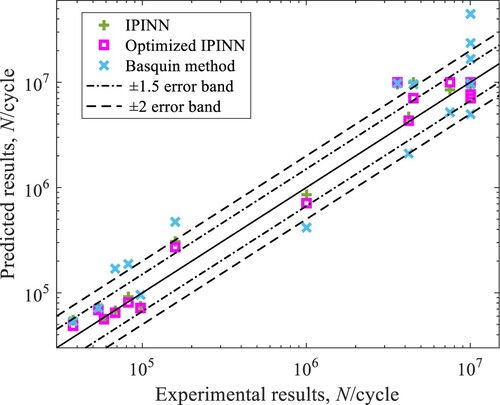
Table 8. Prediction result analysis and performance evaluation of optimised IPINN and Basquin method on the test set.
Furthermore, to compare the prediction accuracy of Basquin's formula and IPINN, Basquin’s curves are fitted under different conditions, and the fatigue life with different conditions in the test set is predicted. The comparison results are shown in and .
, and show that the predictive performance of the optimised IPINN is further improved in both the training and test sets. Among them, the MAPE of prediction results for optimised IPINN on the test set is 27.00%, and the distribution of prediction results within the 1.5 error band, between the 1.5 to 2 error band and outside the 2 error band is 90%, 5%, and 5%, respectively. The results show that the IPINN optimised by network structure has better prediction accuracy and generalisation performance. It is worth noting that the MAPE of Basquin's prediction result is 88.34%. Compared with ANN and IPINN, Basquin's formula has the worst prediction accuracy. It indicates that ML has higher prediction accuracy under multiple conditions, and the integration of multi-physics information enables the model synergistically limited by different physical constraints during the training process, which is beneficial to further improve the prediction accuracy of the model.
5. Conclusions
In this work, we proposed a comprehensive framework for integrating physical information into the neural network. By integrating the enhanced features of the AM-CDM model, the activation function fusing with fatigue limit, and the loss function constructed based on the Basquin formula into the neural network, the IPINN is developed for fatigue life prediction. Validation of the neural network, integrating multiple physical information, is performed using LPBF Hastelloy X with varying orientations, post-treatments and test temperatures.
The AM-CDM model results serve as input features for domain knowledge enhancement, and the AM-CDM theory is introduced into the neural network architecture. The model improves its predictive performance by capturing and learning the fatigue damage evolution law of LPBF Hastelloy X. The MAPE of KENN’s prediction results stands at 39.12%, which is better than ANN, thus verifying the effectiveness of leveraging domain knowledge to enhance the predictive performance of the neural network.
The physics-informed ReLU activation function constrains the model's prediction range by establishing the fatigue limit life as the upper threshold of the activation function's transformation, thus yielding the prediction results consistent with experiments. Notably, the maximum fatigue life predicted by NN-PAF at low stress is 107, with a MAPE of 36.47%, outperforming ANN. These findings validate that restricting the upper threshold of activation function transformation can effectively improve the physical consistency and prediction accuracy of the model.
A physics-informed loss function is formulated based on the Basquin formula, supplemented by the introduction of LMSE loss term and aimed at enhancing the model's predictive capabilities across diverse conditions. The MAPE of NN-PLF’s prediction results is 35.75%, also superior to ANN. The results indicate that the incorporation of the physical model into the loss function imposes specific constraints and limitations on model training, thereby improving the prediction accuracy and physical fidelity of the model.
By integrating the enhanced features of the AM-CDM model, the activation function fusing fatigue limit, and the loss function constructed based on the Basquin formula into the neural network, a neural network integrating multiple physical information is developed. The MAPE of IPINN’s prediction results is 28.91%, exhibiting superior prediction accuracy compared to ANN, KENN, NN-PAF and NN-PLF. The results indicate that through the integration of multiple physical information, the model can more comprehensively capture the physical information of the fatigue process and improve prediction accuracy by subjecting the model to diverse physical constraints during training. Furthermore, optimising the network structure can further improve the predictive performance of the model, yielding a MAPE of 27.00%.
CRediT author contribution statement
Haijie Wang: writing-original draft, investigation, methodology and visualisation. Bo Li: investigation, methodology, revising draft, supervision, funding acquisition and validation. Liming Lei: investigation, methodology and data curation. Fuzhen Xuan: conceptualisation, resources and supervision.
Disclosure statement
No potential conflict of interest was reported by the author(s).
Data availability statement
Data will be made available on request.
Additional information
Funding
References
- Blakey-Milner B, Gradl P, Snedden G, et al. Metal additive manufacturing in aerospace: a review. Mater Des. 2021;209:110008. doi:10.1016/j.matdes.2021.110008
- Abderrafai Y, Diouf-Lewis A, Sosa-Rey F, et al. Additive manufacturing and characterization of high temperature thermoplastic blends for potential aerospace applications. Compos Sci Technol. 2023;231:109839. doi:10.1016/j.compscitech.2022.109839
- Dzogbewu TC, de Beer DJ. Additive manufacturing of selected ecofriendly energy devices. Virtual Phys Prototyp. 2023;18:e2276245. doi:10.1080/17452759.17452023.12276245
- Macallister N, Becker TH. Fatigue life estimation of additively manufactured Ti-6Al-4V: sensitivity, scatter and defect description in damage-tolerant models. Acta Mater. 2022;237:118189. doi:10.1016/j.actamat.2022.118189
- Zhan Z, He X, Tang D, et al. Recent developments and future trends in fatigue life assessment of additively manufactured metals with particular emphasis on machine learning modeling. Fatigue & Fract Eng Mater Struct. 2023;46:4425–4464. doi:10.1111/ffe.14152
- Lei L, Li B, Wang H, et al. High-temperature high-cycle fatigue performance and machine learning-based fatigue life prediction of additively manufactured hastelloy X. Int J Fatigue. 2024;178:108012. doi:10.1016/j.ijfatigue.2023.108012
- Peng X, Wu S, Qian W, et al. The potency of defects on fatigue of additively manufactured metals. Int J Mech Sci. 2022;221:107185. doi:10.1016/j.ijmecsci.2022.107185
- Sai NJ, Rathore P, Chauhan A. Machine learning-based predictions of fatigue life for multi-principal element alloys. Scr Mater. 2023;226:115214. doi:10.1016/j.scriptamat.2022.115214
- Dang L, He X, Tang D, et al. Pore-induced fatigue failure: a prior progressive fatigue life prediction framework of laser-directed energy deposition Ti-6Al-4 V based on machine learning. Theor Appl Fract Mech. 2024;130:104276. doi:10.1016/j.tafmec.2024.104276
- Cutolo A, Lammens N, Vanden Boer K, et al. Fatigue life prediction of a L-PBF component in Ti-6Al-4 V using sample data, FE-based simulations and machine learning. Int J Fatigue. 2023;167:107276. doi:10.1016/j.ijfatigue.2022.107276
- Jia Y, Fu R, Ling C, et al. Fatigue life prediction based on a deep learning method for Ti-6Al-4 V fabricated by laser powder bed fusion up to very-high-cycle fatigue regime. Int J Fatigue. 2023;172:107645. doi:10.1016/j.ijfatigue.2023.107645
- Centola A, Ciampaglia A, Tridello A, et al. Machine learning methods to predict the fatigue life of selectively laser melted Ti6Al4 V components. Fatigue & Fracture Eng Mater Struct. 2023;46:4350–4370. doi:10.1111/ffe.14125
- Xie RK, Zhong XC, Qin SH, et al. Predicting multiaxial fatigue life of FGH96 superalloy based on machine learning models by considering failure process and loading paths. Int J Fatigue. 2023;175:107730. doi:10.1016/j.ijfatigue.2023.107730
- Wang H, Li B, Gong J, et al. Machine learning-based fatigue life prediction of metal materials: perspectives of physics-informed and data-driven hybrid methods. Eng Fract Mech. 2023;284:109242. doi:10.1016/j.engfracmech.2023.109242
- Zhu SP, Wang LY, Luo CQ, et al. Physics-informed machine learning and its structural integrity applications: state of the art. Philos Trans Royal Soc A: Math. Phys Eng Sci. 2023;381(2260):1–15.
- Zhou C, Wang H, Hou S, et al. A hybrid physics-based and data-driven method for gear contact fatigue life prediction. Int J Fatigue. 2023;175:107763. doi:10.1016/j.ijfatigue.2023.107763
- He G, Zhao Y, Yan C. A physics-informed generative adversarial network framework for multiaxial fatigue life prediction. Fatigue & Fracture Eng Mater Struct. 2023;46:4036–4052. doi:10.1111/ffe.14123
- Chen D, Li Y, Liu K, et al. A physics-informed neural network approach to fatigue life prediction using small quantity of samples. Int J Fatigue. 2023;166:107270. doi:10.1016/j.ijfatigue.2022.107270
- Niu XP, He C, Zhu SP, et al. Defect sensitivity and fatigue design: deterministic and probabilistic aspects in additively manufactured metallic materials. Prog Mater Sci. 2024;144:101290. doi:10.1016/j.pmatsci.2024.101290
- Avoledo E, Tognan A, Salvati E. Quantification of uncertainty in a defect-based physics-informed neural network for fatigue evaluation and insights on influencing factors. Eng Fract Mech. 2023;292:109595. doi:10.1016/j.engfracmech.2023.109595
- Wang LY, Zhu SP, Luo CQ, et al. Defect driven physics-informed neural network framework for fatigue life prediction of additively manufactured materials. Philos Trans Royal Soc A: Math. Phys Eng Sci. 2023;381(2260):1–23.
- Tognan A, Patanè A, Laurenti L, et al. A Bayesian defect-based physics-guided neural network model for probabilistic fatigue endurance limit evaluation. Comput Methods Appl Mech Eng. 2024;418(Part A):116521. doi:10.1016/j.cma.2023.116521
- Wang L, Zhu SP, Luo C, et al. Physics-guided machine learning frameworks for fatigue life prediction of AM materials. Int J Fatigue. 2023;172:107658. doi:10.1016/j.ijfatigue.2023.107658
- Salvati E, Tognan A, Laurenti L, et al. A defect-based physics-informed machine learning framework for fatigue finite life prediction in additive manufacturing. Mater Des. 2022;222(0):111089. doi:10.1016/j.matdes.2022.111089
- Fan JL, Zhu G, Zhu M, et al. A data-physics integrated approach to life prediction in very high cycle fatigue regime. Int J Fatigue. 2023;176:107917. doi:10.1016/j.ijfatigue.2023.107917
- He G, Zhao Y, Yan C. MFLP-PINN: a physics-informed neural network for multiaxial fatigue life prediction. Eur J Mech A Solids. 2023;98:104889. doi:10.1016/j.euromechsol.2022.104889
- Acharya R, Caputo AN, Neu RW. Predicting creep-fatigue and thermomechanical fatigue life of Ni-base superalloys using a probabilistic physics-guided neural network. Fatigue & Fracture Eng Mater Struct. 2023;46:1554–1571. doi:10.1111/ffe.13948
- Zhou T, Jiang S, Han T, et al. A physically consistent framework for fatigue life prediction using probabilistic physics-informed neural network. Int J Fatigue. 2023;166:107234. doi:10.1016/j.ijfatigue.2022.107234
- Shi K, Gu D, Liu H, et al. Process-structure multi-objective inverse optimisation for additive manufacturing of lattice structures using a physics-enhanced data-driven method. Virtual Phys Prototyp. 2023;18(1):e2266641. doi:10.1080/17452759.2023.2266641
- Wang H, Li B, Lei L, et al. Uncertainty-aware fatigue-life prediction of additively manufactured Hastelloy X superalloy using a physics-informed probabilistic neural network. Reliab Eng Syst Saf. 2024;243:109852. doi:10.1016/j.ress.2023.109852
- Kapusuzoglu B, Mahadevan S. Information fusion and machine learning for sensitivity analysis using physics knowledge and experimental data. Reliab Eng Syst Saf. 2021;214:107712. doi:10.1016/j.ress.2021.107712
- Du L, Qian G, Zheng L, et al. Influence of processing parameters of selective laser melting on high-cycle and very-high-cycle fatigue behaviour of Ti-6Al-4 V. Fatigue & Fracture Eng Mater Struct. 2021;44:240–256. doi:10.1111/ffe.13361
- Wang H, Li B, Xuan F. Fatigue-life prediction of additively manufactured metals by continuous damage mechanics (CDM)-informed machine learning with sensitive features. Int J Fatigue. 2022;164:107147. doi:10.1016/j.ijfatigue.2022.107147
- Zhan Z, Li H, Lam KY. Development of a novel fatigue damage model with AM effects for life prediction of commonly-used alloys in aerospace. Int J Mech Sci. 2019;155:110–124. doi:10.1016/j.ijmecsci.2019.02.032
- Zhao W, Fu Z, Fan T, et al. Ontology construction and mapping of multi-source heterogeneous data based on hybrid neural network and autoencoder. Neural Comput Appl. 2023;35:25131–25141. doi:10.1007/s00521-023-08373-8
- Jia X, Guo B. Reliability analysis for complex system with multi-source data integration and multi-level data transmission. Reliab Eng Syst Saf. 2022;217:108050. doi:10.1016/j.ress.2021.108050

